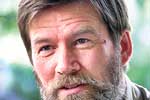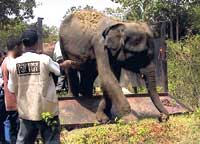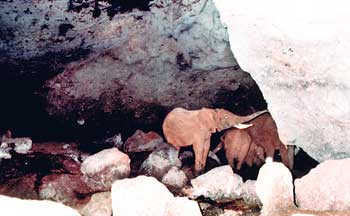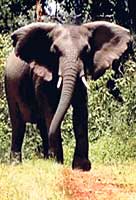
Fighting for the big ones
Whenever he went missing as a baby his mother would look in the monsoon drain. He was small enough to crawl ahead, but his nappy stuck in the drain-gap would give-away his whereabouts that he was following his usual pursuits, interacting with nature, even sans any clothing. Nature……..the babyhood curiosity, which grew into love in boyhood and saw him collecting tadpoles in jam jars, caterpillars and fruit flies and a single egg from the rookery at the top of the tree, became a passion in youth to make him work with semi-domesticated reindeer in Scotland and has seen him turning crusader for animal rights. "I am a biologist by training and conservationist by necessity," says diminutive Ian Redmond OBE, well-known for his work with mountain gorillas or Great Apes along with famous American anthropologist Dian Fossey in Rwanda and also the unique cave elephants of Kenya, unable to fathom how his "unquenchable curiosity of living things" has remained with him and guided his destiny. Coming from a family of musicians, he puts down the fact that he is a naturalist by birth to "a strange mutation". He was born in Malaysia (rich in biodiversity which he prefers) to British parents, when his father who was in the military was stationed there and playfully claims that he was "kidnapped" by his parents and brought to Europe. Now 53 and working as Chief Consultant for the UNEP/UNESCO Great Ape Survival Project and consultant for Born Free, huge are his commitments and promises for, though he has a penchant for any two-legged, four-legged or even the slithery kind (doing research on reptiles and frogs in New Guinea and discovering two new species of frogs), the major battles he has fought and is still fighting are over the big ones.
The passion for elephants and Great Apes is ingrained and that is what he simply cannot stop talking about. "People don't realize that like humans, the big intelligent mammals such as gorillas and elephants have their own special cultures. There is a scientific debate on how to define culture, but it is accepted that it means knowledge being passed from one to another. Citing his findings on his close encounters with the cave elephants in Kenya, Ian also a campaigner against elephants in captivity, who was in Sri Lanka over the last weekend to attend a symposium on elephants, creates an unimaginable picture of these majestic creatures going deep, deep down in the dark to "mine" for salt to get a balanced diet. The scene is amazing, according to Ian. "Babies alongside mums, digging the rock. The elephants feel their way in total darkness up to 160 metres into the mountain to mine mineral-rich rock in the Kitum Cave at the foot of Mount Elgon in Kenya. Females need more salt when pregnant and lactating and so even baby elephants learn about these subterranean salt-licks and this is an example of elephant culture." Different elephant herds, like different tribes of people, would have a culture unique to them. When in Namibia in February 2006 to "collar" male elephants (to fix tracking collars) for scientists to do long-term studies, supported by Born Free, Ian saw another group of elephants that lived in the desert. They excavate deep down in dry riverbeds to find water and also go to rocks with cracks for water. This type of knowledge was passed along the family and the herd - from mothers and aunts to siblings. Ian following in the footsteps of Fossey -- with whom he worked at the Karisoke Research Centre in the Virunga Volcanoes of Rwanda, living in corrugated iron cabins not only studying the Great Apes but also other species -- made it his mission to do for the cave elephants what Fossey did for the mountain gorillas. Raise their profile in a bid to save these endangered creatures. Ian's links with Fossey who changed people's impressions from that of the largest of apes being "King Kong monsters" to "amiable vegetarians", began when he wrote to her, after he graduated, with the request: "Can I come and help?" and she replied, "Get here we'll try you".
His life seems to have taken a similar path. As Fossey was devastated when she found her favourite Great Ape, 'Digit', decapitated and hands chopped off by poachers (gorilla heads and hands were treasured as trophies) in 1977, he suffered pangs of agony 10 years later when he saw one of his favourite cave elephants, 'Charles' ("named obviously because his ears were sticking out," says Ian, implying the similarity to the heir-in-waiting in Britain) decapitated for his tusks. Sadly, Fossey was found murdered in her cabin in 1985. Like Fossey who turned her research work into active anti-poaching action, with patrols and all, Ian had also been spurred to work for the protection of elephants, setting up in 1987, the African Ele-Fund and two years later, getting together with Born Free (then Zoo Check), Care for the Wild and World Society for the Protection of Animals to raise the profile of elephants. A different kind of "elephant safari" had first brought Ian to Sri Lanka in 1996. It was the first time he saw Asian elephants both in their natural habitat and in captivity, doing a three-week study not only of those here but also in India, Kenya and the Central African Republic. The memories are vivid…..seeing the captive elephants playing in the river at Pinnawela, the wild ones in Uda Walawe and himself sleeping on a rock under the stars at Yala. "I saw elephant dung on the beach at Yala and dream of the day when I would actually see a wild elephant on the beach," he says, adding that he loves the beach too. Sri Lanka lured him once again in 2001 to seek a suitable project for Born Free and in 2002 there he was with Helen Worth of 'Coronation Street' fame filming an appeal for UK TV from the Uda Walawe elephant transit home. Next year too he returned with Helen to open the Elephant Intensive Care Unit at Uda Walawe and donate equipment including an ele-ambulance. Back at a symposium held in Colombo in 2003, he helped draft a letter to the UN on the need for the UN, governments, NGOs and academics to help deal with the human-elephant conflict.
"When I first saw the elephants at Pinnawela I was amazed by the spectacle. Two majestic males were sparring in the water. ut suddenly just 'eh' from the mahout and they stood up rigidly still. A skinny little guy with a pointed stick (one prong to push and the other to pull) controls them. The elephants may not have physical chains like in zoos but they certainly have mental chains," says Ian who has also been reviewing the plight of captive elephants since the early 1990s, explaining that Pinnawela is good but there may be a need to expand it further and allow the elephants to eat when they want, sleep when they want and play in the water when they want. The Uda Walawe elephant transit home from where rescued elephants in trouble are later released back into the wild, is closer to Ian's heart. Stressing that from his studies in the Kitum Cave he has found that elephants are part of a social matrix he speaks with enthusiasm of the connection one elephant made with another in the wild, soon after release from the transit home. "That was infrasonic vocalization." "Elephants not only have a sense of self but also know there is another elephant out there and whether that is a second cousin or not," he says, laughingly adding that an elephant’s brain is equal to four human brains put together.
He says: "Elephants have periodic gatherings like in clans. The young learn mothering instincts while in the herd, practising on the younger brothers and sisters. Males are in a hierarchy or should be in musth to mate. The moment you take an elephant out of the social matrix and plunk it elsewhere, like in a zoo, they will make friends but they will be extremely frustrated and their capability is greatly diminished. We control their lives." Stressing the importance of elephants not only for the survival of humans but also the very survival of our planet, he calls them a "super-keystone species". If we lose them there will be a cascade effect, with firstly the local species and then all species around the world facing extinction. Elephants shape the land, as in the case of the Kitum Cave ones, they are seed dispersal agents, they help plant and prune trees by lopping off the top branches, then allowing more light to fall through so that seeds on the ground would germinate providing food for smaller herbivores. "They are the gardeners of the forest," he says. With only 50 countries, 37 in Africa and 13 in Asia, having these majestic animals, Ian's hope for them is that people will not treat them as ornaments. His impassioned plea is: Give elephants the freedom of choice. |
|
||||||
|| Front
Page | News | Editorial | Columns | Sports | Plus | Financial
Times | International | Mirror | TV
Times | Funday
Times || |
| |
Reproduction of articles permitted when used without any alterations to contents and the source. |
© Copyright
2008 | Wijeya
Newspapers Ltd.Colombo. Sri Lanka. All Rights Reserved. |




